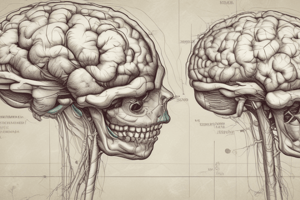Podcast
Questions and Answers
Which cranial nerves begin and end in the medulla oblongata?
Which cranial nerves begin and end in the medulla oblongata?
- VIII, IX, X, and XII (correct)
- III, IV, and VI
- XI, XII, and XIII
- I, II, and III
Which cranial nerve is responsible for movements of the tongue?
Which cranial nerve is responsible for movements of the tongue?
- X
- IX
- VIII
- XII (correct)
Which of the following functions is NOT controlled by a reflex center in the medulla oblongata?
Which of the following functions is NOT controlled by a reflex center in the medulla oblongata?
- Sneezing
- Vomiting
- Hearing (correct)
- Swallowing
How many cranial nerves originate from the medulla oblongata?
How many cranial nerves originate from the medulla oblongata?
What is the main function of the cranial nerve X in the medulla oblongata?
What is the main function of the cranial nerve X in the medulla oblongata?
Which of the following cranial nerves is responsible for transmitting sensory information from the ear?
Which of the following cranial nerves is responsible for transmitting sensory information from the ear?
Which cranial nerve is responsible for facial sensations?
Which cranial nerve is responsible for facial sensations?
Which of the following cranial nerves is involved in eye movement?
Which of the following cranial nerves is involved in eye movement?
Which cranial nerve is responsible for transmitting information related to hearing?
Which cranial nerve is responsible for transmitting information related to hearing?
Which of the following cranial nerves is involved in the secretion of saliva and tears?
Which of the following cranial nerves is involved in the secretion of saliva and tears?
Which cranial nerve is responsible for transmitting information related to taste?
Which cranial nerve is responsible for transmitting information related to taste?
What is the primary function of the cranial nerves?
What is the primary function of the cranial nerves?
Which of the following brain regions contains 50% of the neurons?
Which of the following brain regions contains 50% of the neurons?
What is the term for the deep groove that separates the cerebral hemispheres?
What is the term for the deep groove that separates the cerebral hemispheres?
In which direction does the term 'rostral' refer to?
In which direction does the term 'rostral' refer to?
What is the approximate weight of the brain in men?
What is the approximate weight of the brain in men?
Which of the following is NOT a portion of the brainstem?
Which of the following is NOT a portion of the brainstem?
Flashcards are hidden until you start studying
Study Notes
Brain Structure and Function
- Central sulcus begins at the foramen magnum of the skull, extends about 3 cm rostrally, and ends at a groove just below the pons.
- The brain has four major lobes: frontal, parietal, temporal, and occipital.
- Thalamus, anterior commissure, hypothalamus, habenula, pineal gland, optic chiasm, posterior commissure, mammillary body, epithalamus, and cerebral aqueduct are key structures in the brain.
Medulla Oblongata
- The medulla oblongata is slightly wider than the spinal cord.
- Sensory and motor cranial nerves VIII, IX, X, and XII begin and end in the medulla oblongata, signaling reflex centers for various functions.
- The reticular formation, a loose network of nuclei, extends throughout the medulla, pons, and midbrain, and contains cardiac, vasomotor, and respiratory centers.
The Pons
- The pons is an anterior bulge in the brainstem, rostral to the medulla.
- Ascending sensory tracts, descending motor tracts, and pathways in and out of the cerebellum are found in the pons.
- Cranial nerves V, VI, VII, and VIII have sensory and motor roles, including hearing, equilibrium, taste, facial sensations, eye movement, facial expressions, chewing, swallowing, urination, and secretion of saliva and tears.
The Cerebellum
- The cerebellum contains 50% of the neurons and is the second-largest brain region.
- The cerebellum is located in the posterior cranial fossa.
Brain Evolution and Size
- The human brain is extremely complex, and brain function is associated with what it means to be alive or dead.
- The brain weighs about 1,600 g (3.5 lbs) in men and 1,450 g (3.17 lbs) in women.
- The brain has changed a great deal during evolution, especially in areas of vision, memory, and motor control of the prehensile hand.
Studying That Suits You
Use AI to generate personalized quizzes and flashcards to suit your learning preferences.


